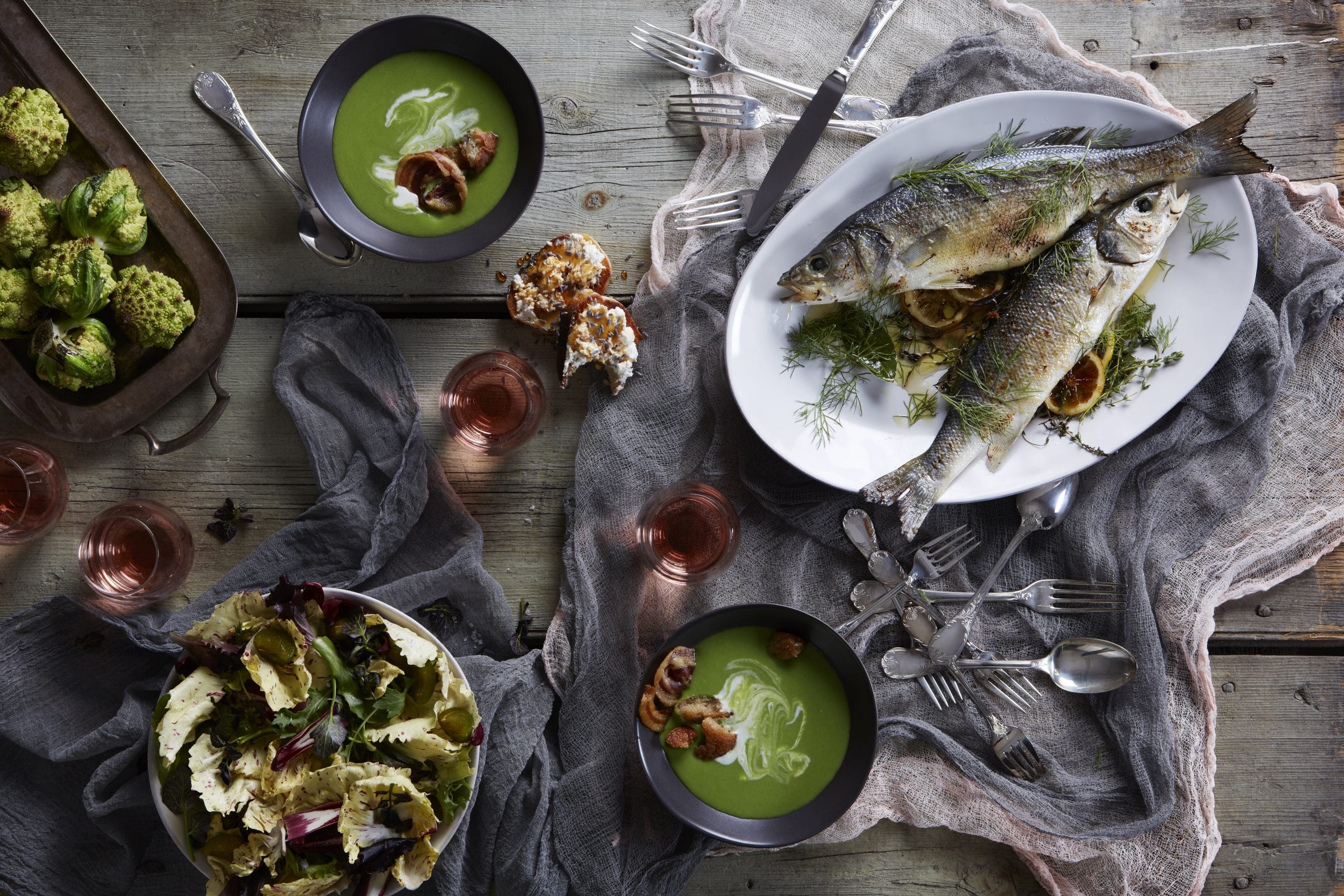What Is Branzino?
Important Note: When you buy through our links, we may earn a commission. As an Amazon Associate we earn from qualifying purchases. Content, pricing, offers and availability are subject to change at any time - more info.
Loved by celebrity chefs and with a catchy Italian name, you’ve probably noticed how popular branzino has become. This trendy fish is on menus everywhere and becoming more and more available in US stores. But how does this fish taste, and how do you cook it? What is branzino?
Branzino is a mild white fish known as European bass, Mediterranean bass, and loup de mer. Like halibut, branzino has a sweet, delicate flavor and is popular in Italian, Greek, and Portuguese cuisine, where it is usually roasted or grilled. Farmed branzino is widely available.
If you enjoy seafood and love grilling whole fish, you definitely need to try branzino. Read on to learn about what this fish is, how it tastes, how you cook it, and how to buy and store it.
- All About Branzino
- What Does Branzino Taste Like?
- Is Branzino A Healthy Choice?
- How Do You Cook Branzino?
- Which Cooking Methods Are Best For Branzino?
- How Do You Know Your Branzino Is Cooked?
- Which Flavors Go With Branzino?
- Where Can You Buy Branzino?
- Hints When Buying Fresh Fish
- How Do You Store Branzino?
- What Are Good Branzino Substitutes?
- So, What Is Branzino?
All About Branzino
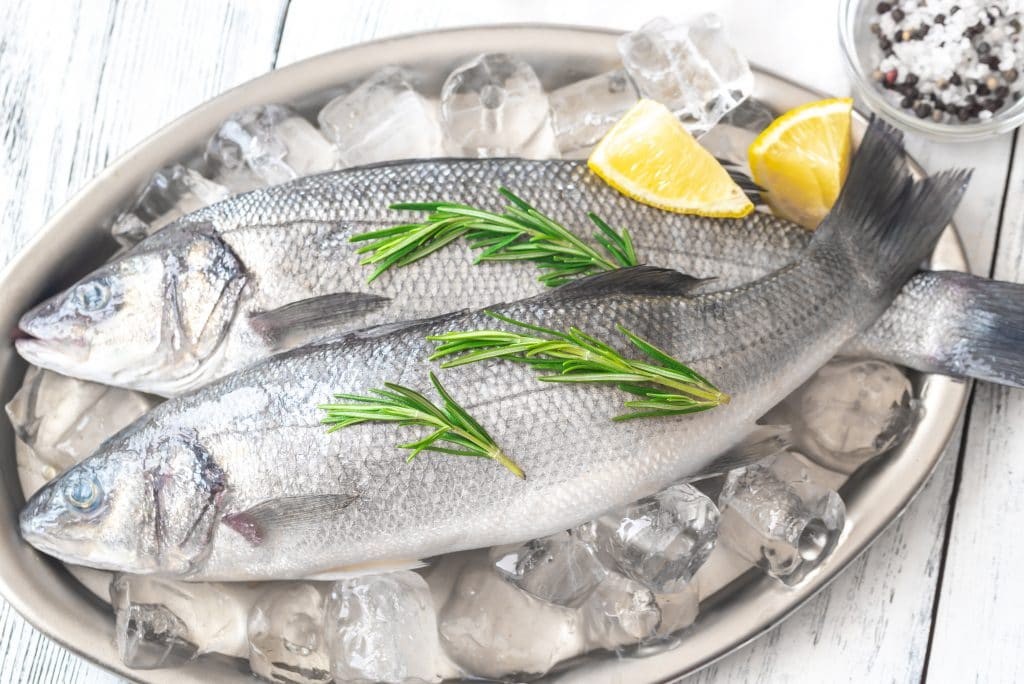
Branzino is a non-oily white saltwater fish with silvery skin. Apart from this Italian name, branzino is also called the European sea bass, Mediterranean Sea bass, lavraki, white salmon, spigola, or lubina, depending on where in the Mediterranean you are.
Also called capemouth, sea perch, and king of the mullets, branzino is a night-hunting, fighting fish, admired by fishermen for its spirit – that’s why it’s also called loup de mer or wolf of the sea.
Most branzino will grow to about 32 inches, weighing between one and three pounds, making a whole fish a good meal for a couple of people.
Branzino originally comes from the western and southern coasts of Europe and the North African coast. You can also find branzino in the eastern Atlantic Ocean, from Norway to Senegal, and the Black Sea.
Although branzino was common in the Mediterranean Sea for millennia – it was eaten in ancient Rome – over-fishing has all but wiped out the wild fish population. Recreational anglers still enjoy catching this prized fish, but there is minimal commercial wild harvesting of branzino.
Most branzino you buy today is farmed fish, with branzino fish farms becoming common across the Mediterranean region, especially in Italy, Spain, Croatia, Greece, and Turkey since the early 2000s. Farming of branzino also takes place in Norway, Canada, and the east coast of the US, in Connecticut. Branzino thrives in the recirculating tanks at fish farms and can survive in saltwater, brackish water, and even freshwater, like tilapia.
This increase in aquaculture explains why the once rare and expensive branzino is now more commonly available in the US – you’re buying farmed, not wild fish, which is a sustainable option.
What Does Branzino Taste Like?
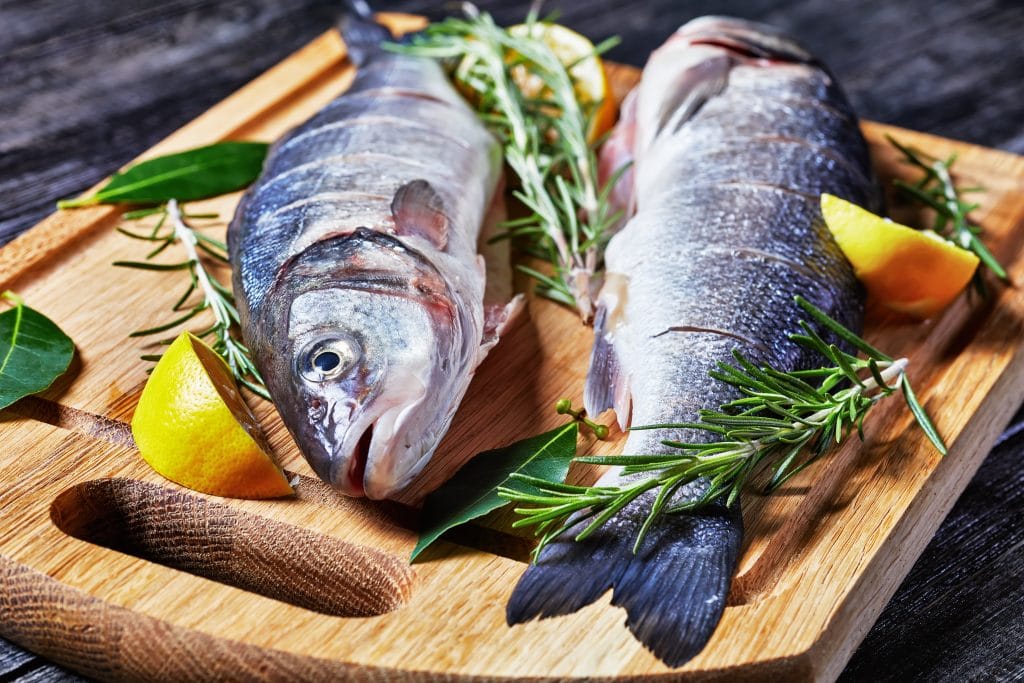
Branzino is a mildly flavored fish with sweet, buttery, flaky flesh. Branzino is an excellent choice for people who don’t like the texture or the overly fishy flavor of oily fish.
Because of its delicate taste and light, silky texture, branzino does well with tangy ingredients, like lemon, chili, fennel, tomatoes, and lemongrass.
Branzino is similar to sea bass or halibut in flavor, making these suitable substitutes.
Is Branzino A Healthy Choice?
Fish provides critical nutrients, especially for children, so is a vital part of a healthy diet. Official dietary guidelines suggest that we should be eating at least eight ounces of fish twice to three times a week to benefit heart, bone, and digestive health.
Branzino is an exceptionally healthy choice of fish. It contains vitamins A and B, the fat-soluble vitamins A and E, protein, amino acids, iodine, magnesium, phosphorus, potassium, zinc calcium, and all-important iodine. A portion of branzino will provide you with over half your recommended daily intake of vitamin D and a third of your required selenium.
Being a lean fish, branzino is a low-calorie choice, with a pound of fish containing 300 calories and no unhealthy saturated fats. However, despite branzino being a non-oily fish, you will still get a good dose of heart-healthy omega-3 fatty acids, which help fight stroke, obesity, and hypertension.
Making branzino part of your diet provides you with an immune booster, an anti-cancer agent, and a promotor of bone growth.
If you have concerns about the levels of mercury and other toxins in branzino, rest assured. The US-FDA lists European sea bass as a “best choice” as it has low levels of these toxins and is safe for infants and children.
How Do You Cook Branzino?
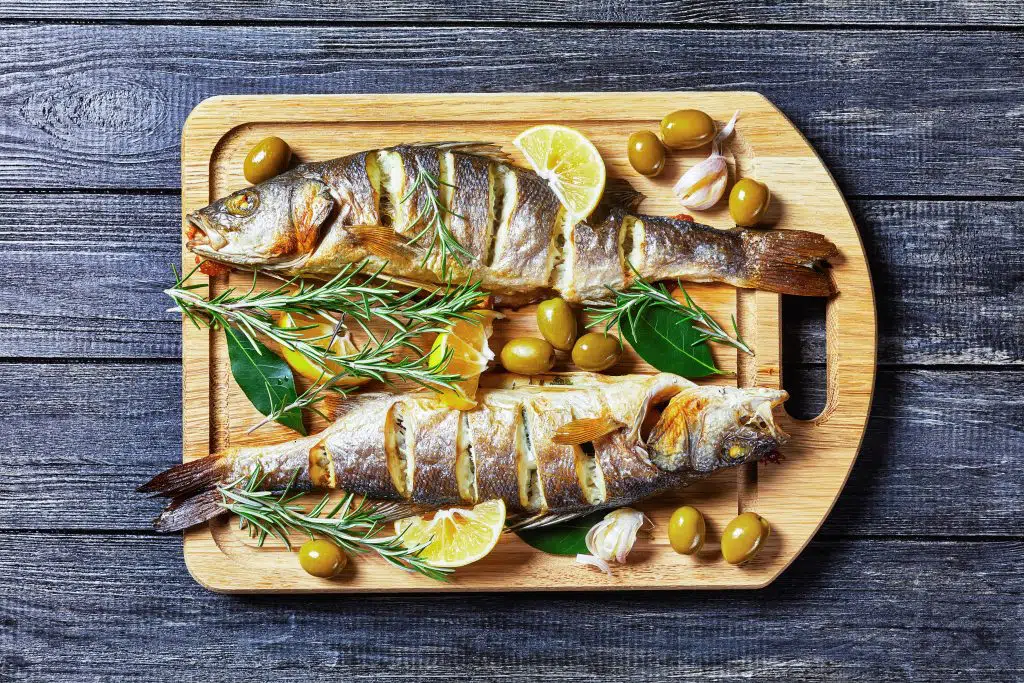
A firm, white fish with a mild taste, branzino lends itself to various cooking methods and flavor profiles. You can eat it whole, butterflied, filleted, or even flaked into pasta, stews, and casseroles.
Ensure that your fish is gutted, scaled, and washed before cooking it.
Which Cooking Methods Are Best For Branzino?
The most popular ways of preparing branzino include grilling, sautéeing, steaming, and roasting.
Roasting And Grilling
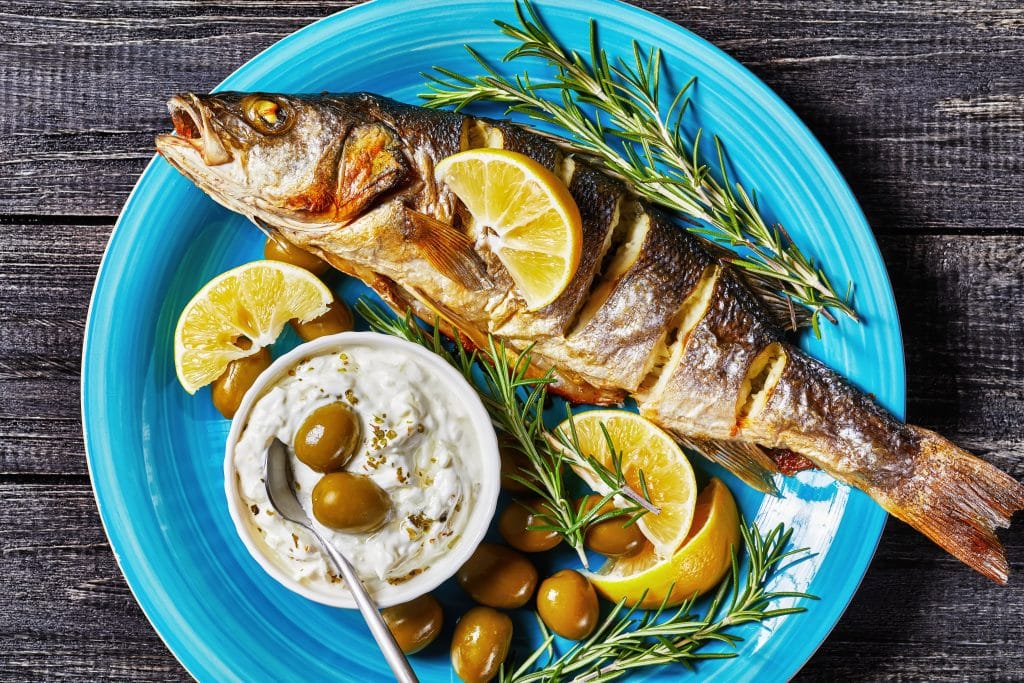
Most recipes you’ll find for branzino are for roast or grilled whole fish. Roasting a whole fish is an ideal cooking method as branzino is a relatively small fish (a two-pound fish is perfect for two people) with a simple bone structure and easily removable bones. So, if you’ve never cooked a whole fish, branzino is an ideal fish to start with.
Roasting a fish whole with bones intact ensures a lot more flavor, while the fish’s skin chars and crisps up beautifully, and the flesh remains moist.
If you’re nervous about cooking a whole fish, get your fishmonger to scale and gut it for you. If you prefer that, they will remove the head or even butterfly your branzino for you for grilling convenience.
To bake or roast branzino, season it with salt and pepper and then stuff with lemon and herbs. This preparation is typical of Italian and Greek traditions for cooking branzino.
Although you can grill branzino on the barbecue or in the oven, roasting the fish in a paper wrapper (al cartoccio in Italian) ensures that the fish remains moist and tender.
It will take about 25 minutes to roast stuffed, whole branzino at 325⁰F. Always let fish rest before serving. If you’ve got a filleted or butterflied fish, it will only need four to seven minutes per side on the barbecue or under the grill.
Garnish grilled branzino with a twist of lemon and fresh herbs.
Steaming
With its delicate, flaky flesh, branzino is also delicious steamed. Season the fish with lemon juice, herbs, a dry rub, or Asian-style seasonings, like lemongrass, lime leaves, and chili.
Either serve the fish whole, or flake the cooked fish into a pasta, pie, or casserole.
Sautéeing
Pan-frying and sautéeing are excellent methods of cooking branzino fillets, preventing them from drying out.
Use olive oil (or combine butter and olive oil) for flavor and to crisp the fish’s skin. Drizzle with lemon juice once the fish is done, or finish it with soy, oyster, or teriyaki sauce.
How Do You Know Your Branzino Is Cooked?
According to the legendary cooking authority James Beard, you should cook fish for ten minutes per inch, whichever cooking method you are using or the type of fish you are cooking.
However, it’s best to recognize the signs of doneness in fish: cooked fish has firm flesh, looks opaque, is not translucent, and flakes easily with a fork. Test fish by gently prodding between the flakes with a sharp, thin-bladed knife.
If you are nervous about cooking fish, use an instant-read or meat thermometer to check that it is thoroughly cooked. Ensure that you cook your branzino until the center or thickest part of the fish is 145⁰F. If you prefer your fish slightly rare, cook it to 120⁰F.
Remember that your fish continues cooking even when it’s taken off the heat.
Which Flavors Go With Branzino?
Being a Mediterranean fish, you’ll find inspiration in flavors from this region. However, branzino’s mild flavor also makes it an ideal fish for Asian-style preparation.
Best Herbs
Herbs that pair well with branzino are parsley, oregano, fennel, rosemary, dill, thyme, cilantro, and lemongrass.
Best Vegetables
Cook branzino with bright tomatoes, roast peppers, and robust olives to bring out its flavor. Celery is excellent for crunch, while garlic and green and sweet onions are a dependable pairing for all fish.
Because it is mild, you can also add chili or capers to branzino, especially to a marinade.
Best Marinades And Dressings
It tastes great grilled with a drizzle of olive oil and a squeeze of lemon or lime juice, while white wine is also a match for poaching or dribbling.
Best Sides For Branzino
Serve branzino with a plain side, like couscous, rice, potato salad, roast potatoes, or crusty bread. A fresh salad always goes well with fish, like roast vegetables, like carrots and broccoli.
Where Can You Buy Branzino?
Most seafood restaurants will have branzino on the menu, but if you want to cook it yourself, look at your nearest fish shop, fish market, or large grocery store with a fishmonger. You can also order branzino online.
Farmed branzino is quite economical, and you can get it for around $10 per pound. If you’re paying a lot more for branzino, you’ve probably found wild branzino, line-fished, and imported from Europe.
Sometimes branzino will be labeled European sea bass, but don’t confuse it with Chilean sea bass, another fish entirely, or the American black bass.
Hints When Buying Fresh Fish
Most branzino you find will be the fresh fish — you don’t often see it frozen. Branzino is sold whole, usually gutted, and sometimes scaled as well.
Always buy fish stored on ice or in an icy refrigerator – commercial refrigerators should be set to 33⁰F at least.
Check out the fish first to make sure it is fresh. The best whole fish always look as if they are still alive.
The eyes and scales are the biggest giveaways as cloudy eyes, and dull scales indicate a fish past its prime. Instead, choose a fish with shiny eyes and bright, metallic silver scales: pink or brown spots indicate bruising and spoilage. The gills should be bright red. Fresh branzino should have a gently briny smell. If the fish smells very fishy or foul, avoid it.
How Do You Store Branzino?
Fish is notoriously tricky in terms of storage, as home refrigeration is not strictly cold enough to keep it fresh. However, you should have no problems with your branzino if you don’t leave fresh or cooked fish in the fridge for more than a day or two.
Fresh Branzino
- Try to cook your fish on the day you buy it — your branzino will already be a few days old when you buy it because of transportation.
- You can store your branzino in the fridge, wrapped tightly in plastic for two days but remember that fish goes bad very quickly.
- Fill a baking tin with ice or ice packs. Then bury your wrapped fish in there to maintain its quality for as long as possible.
- Ensure that the fish is in airtight wrapping or a container so that the smell of fish doesn’t penetrate your other food.
- If you know you’re not going to eat the fish immediately, freeze it in airtight wrapping and a Ziploc bag for up to a month. Thaw frozen fish in the fridge overnight, then cook the next day.
Cooked Branzino
- You may have leftovers, especially if you have cooked a whole fish. Store leftover branzino in an airtight container in the fridge for up to three days.
- Reheat leftover fish gently in a skillet on the stove. You can also flake cooked fish into a pasta sauce or stir fry.
What Are Good Branzino Substitutes?
If you can’t find branzino at your local fish market, use another white fish: choose from red snapper, croaker, striped bass, American or Atlantic black sea bass, halibut, flounder, or Pacific rock cod.
So, What Is Branzino?
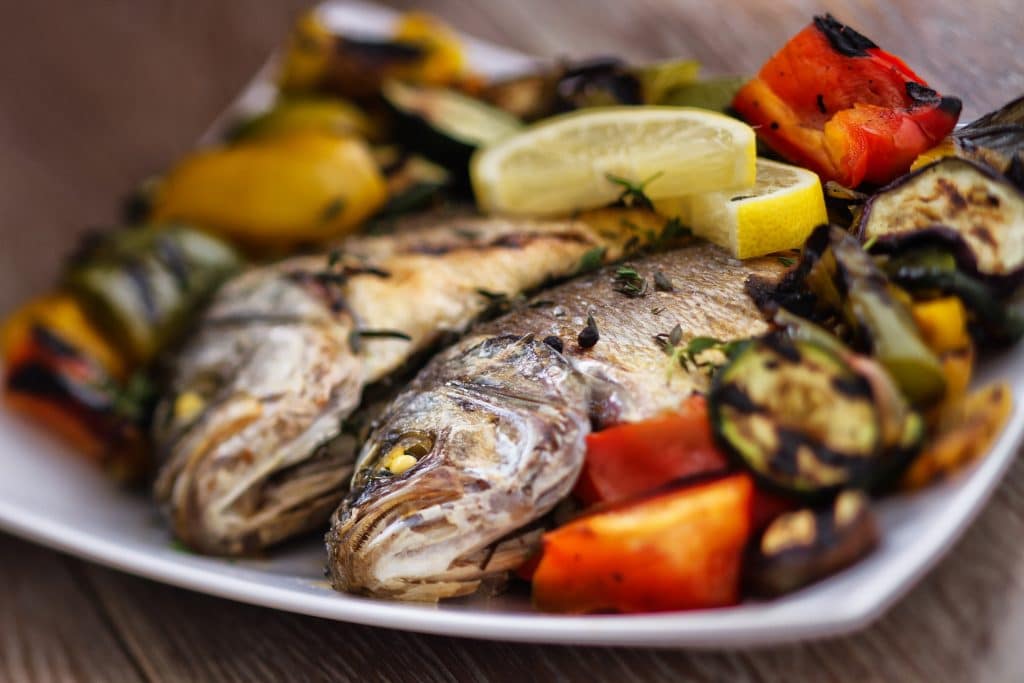
Branzino or European sea bass is an excellent choice of white fish for grilling or roasting whole. Highly nutritious, this mildly flavored, flaky fish is widely available and easy to cook. Choose branzino for your next barbecue or Italian-themed evening.
